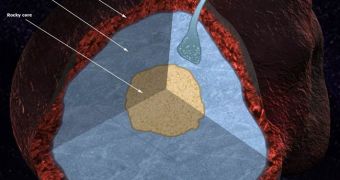A team of astronomers proposes that Kuiper Belt objects that have a reddish hue may in fact owe their color to the presence of complex organic molecules, that could form the building blocks of life.
If this turns out to be true, then the discovery could have significant consequences for the way life developed here on Earth, and for the chances it has of appearing somewhere else in the solar system, or the Universe, as well.
The Kuiper Belt is an area of our solar system extending beyond the orbit of Pluto, where several dwarf plants and thousands of asteroids, comets and other space rocks exist.
Telescope studies conducted on the area have revealed that existence of colored space bodies, which display shades of red, white and blue when viewed at high levels of magnification.
The new computer model suggests that these bodies may in fact get their respective colors from layers of molecules on their surface, of which some, the red ones, may be organic compounds.
If researchers determine that the new study came to the correct conclusions, then the discovery would support the idea stating that organic molecules can in fact be commonly found in the Universe.
If that is true, then the chances of life appearing and developing somewhere else in the Milky Way or beyond also increase. Couples with recent studies showing that Earth-like planets are common, the new work could demonstrate that life may not be uncommon in the Cosmos.
“We're not saying that life is produced in the Kuiper Belt. But the basic chemistry may start there, as could also happen in similar Kuiper Belt environments elsewhere in the universe, and that is a natural path which could lead toward the chemical evolution of life,” says expert John Cooper.
He holds an appointment as a physicist at the American space agency's Goddard Space Flight Center (GSFC), in Greenbelt, Maryland.
Most of the 1,000+ Kuiper Belt objects that were imaged this far could in fact be made up of several layers of material, say astronomers who conducted the observations sessions, Space reports.
“This multi-layer model provides a more flexible approach to understanding the diversity of colors. The model calculates the rate at which energy comes in from radiation and could be causing changes at different depths,” Cooper explains.
“So we can define different layers based on that,” he goes on to say. The scientists detailed this idea at the Division for Planetary Sciences meeting of the American Astronomical Society, which was held in October in Pasadena, California.
“When you take the right mix of materials and radiate them, you can produce the most complex species of molecules. In some cases you may be able to produce the components of life – not just organic materials, but biological molecules such as amino acids,” Cooper explains.

 14 DAY TRIAL //
14 DAY TRIAL //